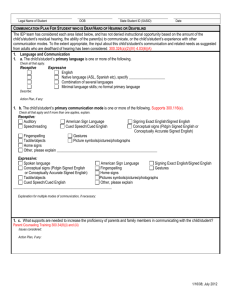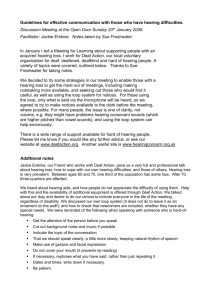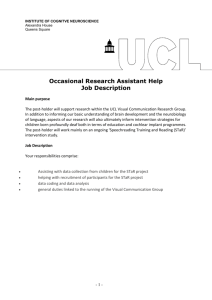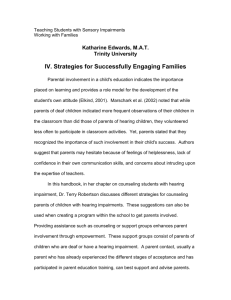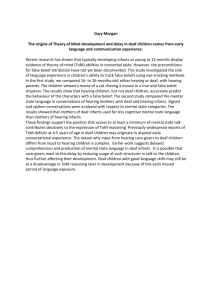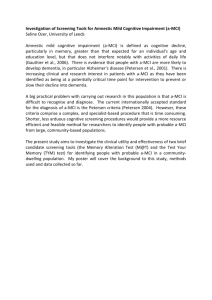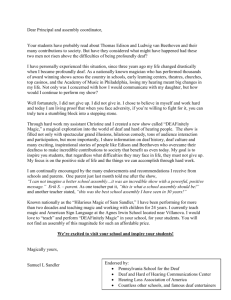Topical Session 1- 1710
advertisement
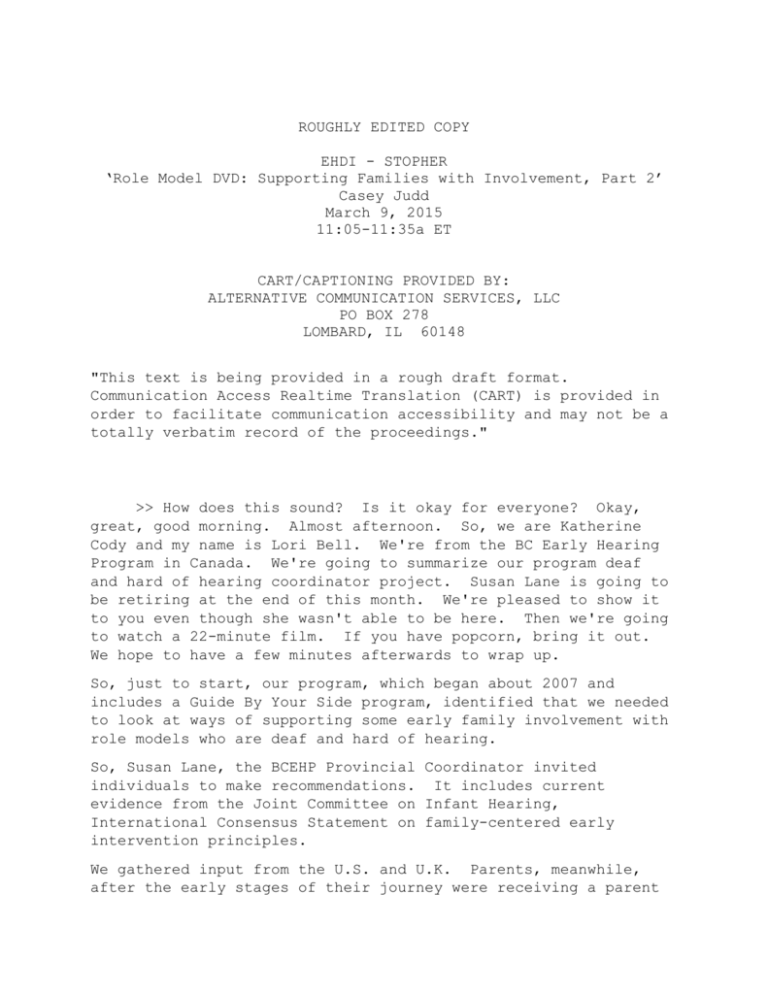
ROUGHLY EDITED COPY EHDI - STOPHER ‘Role Model DVD: Supporting Families with Involvement, Part 2’ Casey Judd March 9, 2015 11:05-11:35a ET CART/CAPTIONING PROVIDED BY: ALTERNATIVE COMMUNICATION SERVICES, LLC PO BOX 278 LOMBARD, IL 60148 "This text is being provided in a rough draft format. Communication Access Realtime Translation (CART) is provided in order to facilitate communication accessibility and may not be a totally verbatim record of the proceedings." >> How does this sound? Is it okay for everyone? Okay, great, good morning. Almost afternoon. So, we are Katherine Cody and my name is Lori Bell. We're from the BC Early Hearing Program in Canada. We're going to summarize our program deaf and hard of hearing coordinator project. Susan Lane is going to be retiring at the end of this month. We're pleased to show it to you even though she wasn't able to be here. Then we're going to watch a 22-minute film. If you have popcorn, bring it out. We hope to have a few minutes afterwards to wrap up. So, just to start, our program, which began about 2007 and includes a Guide By Your Side program, identified that we needed to look at ways of supporting some early family involvement with role models who are deaf and hard of hearing. So, Susan Lane, the BCEHP Provincial Coordinator invited individuals to make recommendations. It includes current evidence from the Joint Committee on Infant Hearing, International Consensus Statement on family-centered early intervention principles. We gathered input from the U.S. and U.K. Parents, meanwhile, after the early stages of their journey were receiving a parent kit. That did contain a few books. One of them being The Book of Choice. Another thing they received was a DVD. That DVD was interviews -- it is interviews with parent who are also going through the process really early and some of their initial experiences and their words of encouragement to new families going through the process. So, I mentioned that Susan Lane gathered a group of individuals together. This deaf and hard of hearing advisory includes deaf and hard of hearing individuals who have experience working with families and includes three parent organizations in BC. Those are BC Hands & Voices and two other organizations that serve families with slightly older children, one of them is called FNDC or the Family Network for Deaf Children in BC and the Canadian Hard of Hearing Association in BC. So the Advisory decided on a video. Phase one is to provide this video as a resource to introduce parents of deaf and hard of hearing individuals early on in their journey after identification. So, it's an opportunity for parents, really to learn from young adults who are deaf and hard of hearing, really early on. And phase two, we're really excited to say is going to be added to, is going to be to add deaf and hard of hearing guides to our Guide By Your Side program. So, we're really excited, we're talking to everyone and I'm trying to gather lots of information about that to take back to your guide by your side coordinator in BC. So, just to go through a few of the highlights in the making of this video, the deaf and hard of hearing advisory identified the key purpose and messages of the video collaboratively. That group that I mentioned earlier, they were the ones that came up with these messages and purpose. The deaf and hard of hearing advisory also created a list of potential participants for the video to be interviewed. The project team included BC Early Hearing Program, our team, a deaf consultant and a parent consultant with experience in health education through media. The, the video is also captioned in ten languages, we have a very diverse population linguistically and culturally. Next, I'm going to play the video, but I want to go over a few of the key messages and a few of what the deaf and hard of hearing advisory group identified around the list of potential participants. So, they wanted the participants in the video to really show a range of experiences, including, having a range of hearing levels or diversity in their hearing status, to have a range of language and communication access, ways of accessing communication and using language. They wanted the participants to be culturally diverse, to represent what, you know, families and people who really are in BC. They also wanted to have both genders represented and have a real range of participant interests and successes and challenges and so, that included also, some individuals who are deaf or hard of hearing with additional needs as well. So, some of the key messages they came up with were messages around giving the idea of hope to parents that "my child will be okay." That deaf and hard of hearing individuals have happy lives. They also wanted to show different, there are different ways to be successful. So this video was known to show the superstars coming out of programs, but rather, just individuals who are successful in many different ways and how they define success barriers, different accessibility kinds of issues for these individuals. They wanted a variety of languages and communication approaches and finally, they want, really, to show parents to see the person first and then, you know, that they are deaf or hard of hearing as an aspect of who they are. But it doesn't define them. Their hearing isn't the one defining feature of who they are as an individual. However...on one side, they also want the message to come across that identity is important to people who are deaf and hard of hearing. Okay...so, we're going to play the DVD. This is the challenging part. I can't see it, there it is. I totally lost it now. I think it's there. Okay, I'm going to start it this way, I can't find it. Oh yeah, yeah. Yeah, when I minimize, I don't know where it is. Okay...here we go. [Video]. >> So, we're out of time, I'm sorry we went over a little bit. Thanks for coming. [applause] "This text is being provided in a rough draft format. Communication Access Realtime Translation (CART) is provided in order to facilitate communication accessibility and may not be a totally verbatim record of the proceedings."

